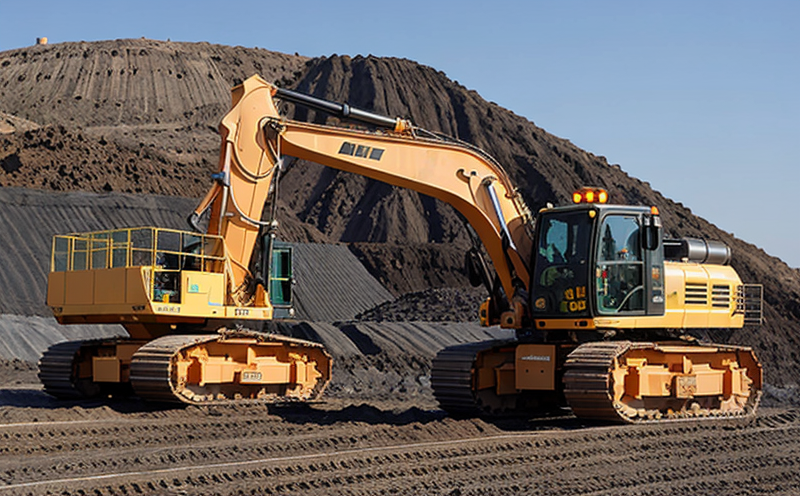ISO 10263 Operator Enclosure Climate Control Performance Testing
The ISO 10263 standard specifies the performance requirements and testing procedures for operator enclosures used in mining equipment. These enclosures are designed to protect operators from harsh environmental conditions, ensuring their safety while they perform critical tasks underground or in other challenging environments.
Compliance with ISO 10263 is essential for manufacturers of mining equipment who wish to ensure that their products meet the highest standards of occupational health and safety. The test involves simulating various environmental stressors such as temperature, humidity, dust, and vibration to assess how well the operator enclosure performs under these conditions.
The testing process typically begins with thorough specimen preparation, where the operator enclosure is mounted on a suitable rig that can replicate real-world operating conditions. This includes positioning it in a climate chamber capable of reproducing temperatures ranging from -20°C to +50°C and relative humidity levels between 10% and 95%. The enclosure must also withstand vibration tests according to ISO standards.
Once the specimen is prepared, testing begins with temperature cycling. This involves gradually increasing or decreasing the internal temperature of the enclosure while monitoring the operator's comfort level using thermal sensors placed inside the cab. Simultaneously, humidity levels are controlled within specified ranges to evaluate how effectively moisture is managed by the enclosure.
Vibration tests follow, simulating the dynamic loads experienced during typical mining operations. These can range from low-frequency oscillations to high-frequency impacts, depending on the type of equipment being tested. During this phase, the integrity of the enclosure structure and its ability to maintain a stable internal environment despite external disturbances are carefully observed.
Following completion of these primary tests, additional checks may be carried out to assess other aspects such as sound insulation properties, air flow patterns within the cab, and overall durability. All findings from these assessments form part of comprehensive reports submitted to clients or regulatory bodies as evidence that compliance has been achieved.
In summary, ISO 10263 operator enclosure climate control performance testing is crucial for maintaining worker safety standards in mining environments. By adhering strictly to this international standard, manufacturers can demonstrate their commitment to producing robust and reliable equipment tailored specifically for use in challenging conditions.
Benefits
The implementation of ISO 10263 operator enclosure climate control performance testing offers numerous benefits beyond mere compliance with industry regulations. It enhances overall product quality by identifying potential weaknesses early in the development cycle, thereby reducing costly rework and recalls later on.
For quality managers, this service provides a clear roadmap for meeting stringent safety standards set forth by relevant authorities around the world. Compliance officers will find it invaluable as they navigate complex compliance landscapes, ensuring that all necessary documentation is prepared accurately and timely.
R&D engineers benefit greatly from detailed insights gained through rigorous testing protocols, allowing them to innovate more effectively based on empirical data rather than guesswork alone. Procurement professionals can rest assured knowing that suppliers delivering compliant products meet exacting quality benchmarks.
Ultimately, investing in ISO 10263 compliance not only protects workers but also strengthens brand reputation among stakeholders concerned with safety and sustainability practices.
Quality and Reliability Assurance
The ISO 10263 standard plays a pivotal role in establishing robust quality assurance processes for mining equipment manufacturers. By incorporating this testing into their product development cycles, companies can significantly enhance the reliability of their offerings.
One key aspect involves continuous monitoring and adjustment during manufacturing to ensure each operator enclosure meets exacting specifications right from the start. This proactive approach helps catch any deviations early on before they become costly issues further down the line.
In addition, regular audits conducted by independent third parties help maintain consistent adherence to ISO 10263 standards throughout production runs. These inspections provide valuable feedback that guides improvements continuously improving product performance over time.
Overall, implementing robust quality and reliability assurance measures based on ISO 10263 ensures not only regulatory compliance but also builds trust among end-users who rely heavily upon the safety features provided by such enclosures.
Use Cases and Application Examples
| Use Case | Description | Application Example |
|---|---|---|
| Data Logging and Recording | Continuous monitoring of temperature, humidity, and other relevant parameters during testing. | A manufacturer records data from a climate chamber test simulating extreme temperatures to verify enclosure performance. |
| Vibration Testing | Evaluation of how well the enclosure withstands mechanical stress caused by mining machinery operations. | An operator tests an enclosure's resilience against vibrations generated while operating heavy earth-moving equipment underground. |
| Thermal Management Evaluation | Determining if the enclosure effectively maintains optimal internal temperature for operator comfort and safety. | A company assesses whether an enclosure can keep a consistent 25°C inside despite external temperatures dropping to -10°C. |
| Humidity Control Assessment | Checking the ability of the enclosure to prevent condensation and maintain dry conditions within the cab. | A firm evaluates an enclosure's humidity levels during prolonged exposure to high humidity environments. |
| Sound Insulation Analysis | Evaluating soundproofing effectiveness of the enclosure against noise generated inside and outside. | An organization measures sound insulation properties to ensure minimal external noise intrusion into the cab. |
| Air Flow Pattern Inspection | Assessing airflow distribution within the operator's workspace for optimal comfort and health. | A manufacturer inspects air flow patterns inside an enclosure to ensure uniform temperature distribution. |





